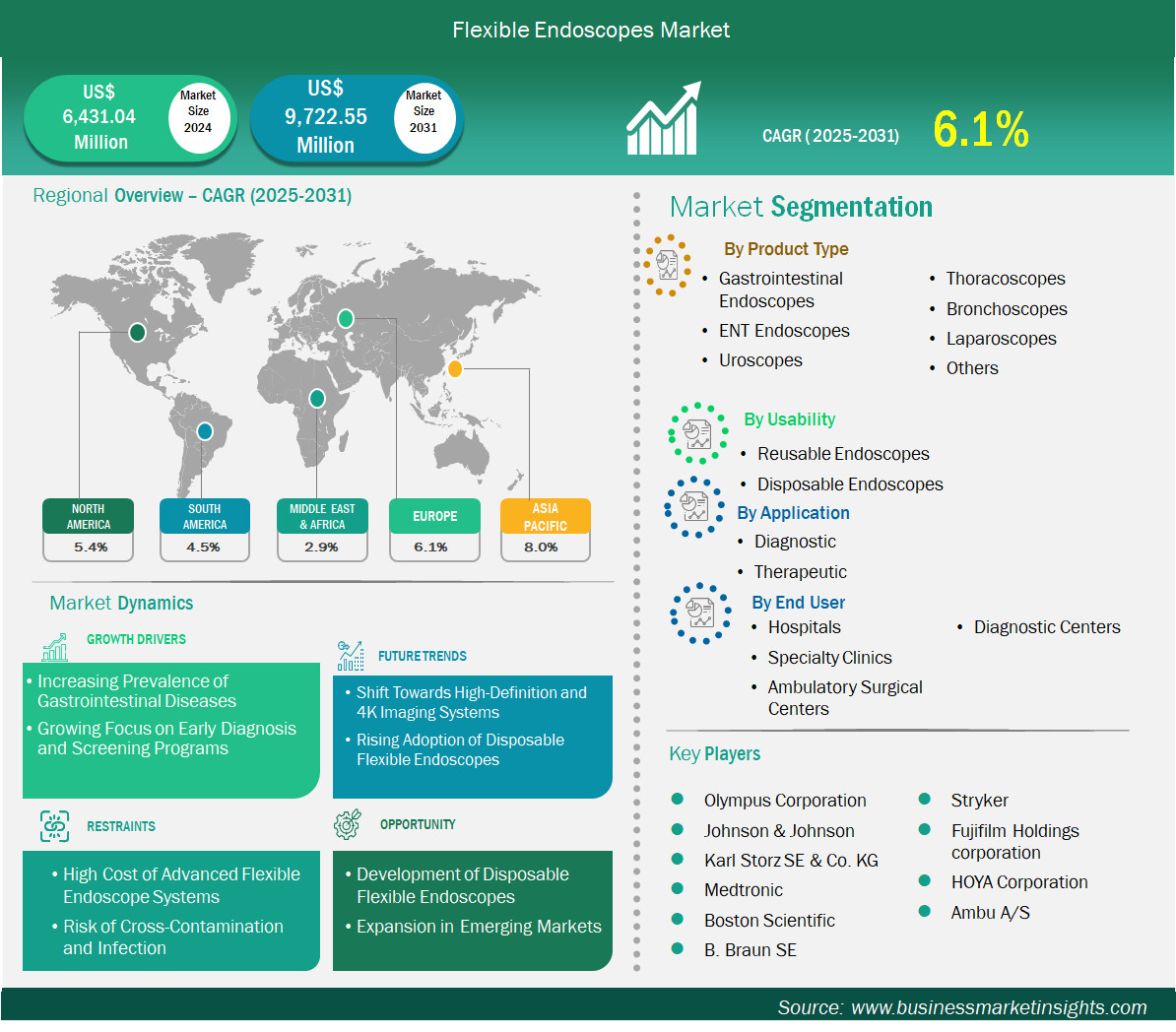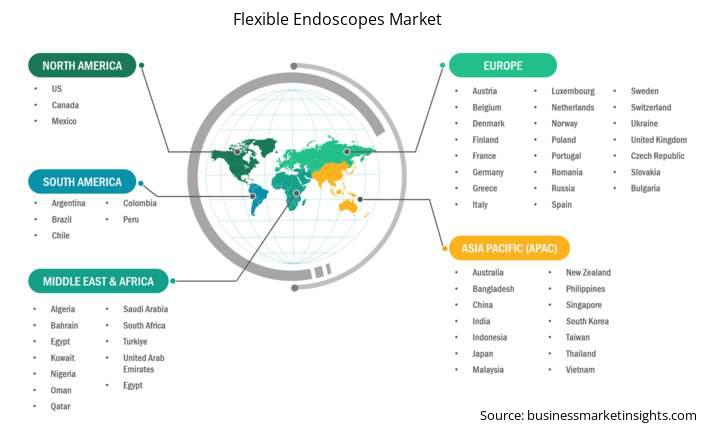Flexible Endoscopes Market Outlook (2021-2031)
No. of Pages: 200 | Report Code: BMIPUB00031681 | Category: Life Sciences
No. of Pages: 200 | Report Code: BMIPUB00031681 | Category: Life Sciences
The flexible endoscopes market size is expected to reach US$ 9,722.55 million by 2031 from US$ 6,431.04 million in 2024. The market is estimated to record a CAGR of 6.1% from 2025 to 2031.
The flexible endoscope market is thriving due to the growing demand for minimally invasive diagnostic and therapeutic procedures. Flexible endoscopes guide through curved or complex anatomical pathways, making them widely useful in medicine, gastroenterology, pulmonology, urology, and ENT. They foster colonoscopy, bronchoscopy, cystoscopy, EGD procedures that demand patient consideration and precision. The rising cases of gastrointestinal and respiratory illnesses and increasing awareness of the early detection of diseases are pushing the demand for flexible endoscopic procedures. Imaging technologies such as HD, 4K, and narrow-band imaging are further aiding in improving diagnostic precision. The market will continue to grow as demand for ambulatory care increases.
In line with the adoption rate, the global flexible endoscopes market stood at US$ 6,431.04 million in 2024 and is expected to reach US$ 9,722.55 million by 2031. The high cost of equipment coupled with risk of cross-contamination presents certain areas of concern. However, the overall market remains positive.
Flexible Endoscopes Market Strategic Insights

Flexible Endoscopes Market Segmentation Analysis
Key segments that contributed to the derivation of the flexible endoscopes market analysis are product type, usability, application, and end user.
The rising incidence of gastrointestinal (Gl) diseases constitutes a major driver in the flexible endoscopes market. Diseases like colorectal cancer, inflammatory bowel disease (IBC), gastroesophageal reflux disease (GERD), ulcers, and gastrointestinal bleeding are becoming increasingly common with changing lifestyles, poor diet, stress, and aging populations. The conditions necessarily need an accurate and early diagnosis, in which flexible endoscopy stands the gold standard. With the help of procedures like colonoscopy, sigmoidoscopy, and upper Gl endoscopy, the physicians can visualize the gastrointestinal tract directly or get biopsies done or even go for minor intervention. As this burden of chronic digestive disorders increases, mostly in developed and developing countries, there remains a steady pull for diagnostic and therapeutic flexible endoscopic procedures. This brings a push for hospitals and diagnostic centers to invest in advanced high-resolution flexible endoscopes, which in turn leads to overall market and technology growth.
The need for flexible endoscopes is being greatly increased by governments and healthcare institutions worldwide who are emphasizing early disease detection through national screening programs. Flexible endoscopy is especially important for screening for colorectal cancer, which is one of the main causes of cancer-related deaths worldwide. A flexible endoscopic technique called a colonoscopy lowers the risk of cancer by enabling the early detection and removal of precancerous polyps. Similar instruments are employed to identify infections and inflammatory diseases, as well as to detect early-stage stomach and esophageal cancers. Routine endoscopic screenings have increased as a result of public health initiatives and growing patient awareness of the advantages of early diagnosis.
By product type, the flexible endoscopes market is segmented into gastrointestinal endoscopes, ENT endoscopes, uroscopes, thoracoscopes, bronchoscopes, laparoscopes, and others. The gastrointestinal endoscopes segment dominated the market in 2024. Gastrointestinal endoscopes are extensively used for diagnosing and treating digestive tract conditions, including cancers and ulcers, making them the most common flexible endoscope due to high procedure volumes globally.
By usability, the flexible endoscopes market is segmented into reusable endoscopes and disposable endoscopes. The reusable endoscopes segment dominated the market in 2024. Reusable flexible endoscopes dominate usage because of their cost efficiency in repeated procedures, advanced imaging capabilities, and hospitals’ preference for sterilizable equipment over disposables in high-demand environments.
By application, the flexible endoscopes market is segmented into diagnostic and therapeutic. The diagnostic segment dominated the market in 2024. Diagnostic applications lead flexible endoscope use since many procedures focus on visualizing internal organs and detecting diseases early, before moving to therapeutic interventions, resulting in higher diagnostic procedure volumes.
By end user, the market is segmented into hospitals, specialty clinics, ambulatory surgical centers and diagnostic centers. The hospitals segment held the largest share of the market in 2024. Hospitals handle the highest procedure volumes, covering diverse specialties and equipped with advanced infrastructure, making them the top users of flexible endoscopes for both diagnostic and therapeutic purposes.
Flexible Endoscopes Market Report Highlights
Report Attribute
Details
Market size in 2024
US$ 6,431.04 Million
Market Size by 2031
US$ 9,722.55 Million
Global CAGR (2025 - 2031) 6.1%
Historical Data
2021-2023
Forecast period
2025-2031
Segments Covered
By Product Type
By Usability
By Application
By End User
Regions and Countries Covered
North America
Europe
Asia-Pacific
South and Central America
Middle East and Africa
Market leaders and key company profiles
The "Flexible Endoscopes Market Size and Forecast (2021–2031)" report provides a detailed analysis of the market covering below areas:

The geographical scope of the flexible endoscopes market report is divided into five regions: North America, Asia Pacific, Europe, Middle East & Africa, and South & Central America. The flexible endoscopes market in Asia Pacific is expected to grow significantly during the forecast period.
The Asia Pacific flexible endoscopes market is segmented into China, Japan, South Korea, India, Australia, New Zealand, Indonesia, Malaysia, Philippines, Singapore, Thailand, Vietnam, Taiwan, Bangladesh and Rest of Asia. The Asia Pacific flexible endoscopes market is witnessing strong growth, fuelled by rising cases of gastrointestinal and respiratory diseases, a growing elderly population, and increasing awareness of early disease detection. Because of their growing healthcare systems and government-sponsored screening initiatives, especially for colorectal and stomach cancers, nations like China, India, Japan, and South Korea are leading the way in this expansion. As the demand for preventive care and adoption of minimally invasive diagnostics services grows, the market for flexible endoscopes in Asia Pacific is likely to grow. Disposable endoscopes and HD are examples of technological advancements that urban hospitals are progressively implementing. However, cost sensitivity and a shortage of skilled professionals in rural and underdeveloped areas remain significant challenges. Nevertheless, because of increased healthcare spending, easier access to diagnostics, and a large patient population in need of endoscopic examination, the Asia Pacific region presents substantial opportunities for both domestic and foreign manufacturers.
The flexible endoscopes market is evaluated by gathering qualitative and quantitative data post primary and secondary research, which includes important corporate publications, association data, and databases. A few of the key developments in the flexible endoscopes market are:
The Flexible Endoscopes Market is valued at US$ 6,431.04 Million in 2024, it is projected to reach US$ 9,722.55 Million by 2031.
As per our report Flexible Endoscopes Market, the market size is valued at US$ 6,431.04 Million in 2024, projecting it to reach US$ 9,722.55 Million by 2031. This translates to a CAGR of approximately 6.1% during the forecast period.
The Flexible Endoscopes Market report typically cover these key segments-
The historic period, base year, and forecast period can vary slightly depending on the specific market research report. However, for the Flexible Endoscopes Market report:
The Flexible Endoscopes Market is populated by several key players, each contributing to its growth and innovation. Some of the major players include:
The Flexible Endoscopes Market report is valuable for diverse stakeholders, including:
Essentially, anyone involved in or considering involvement in the Flexible Endoscopes Market value chain can benefit from the information contained in a comprehensive market report.